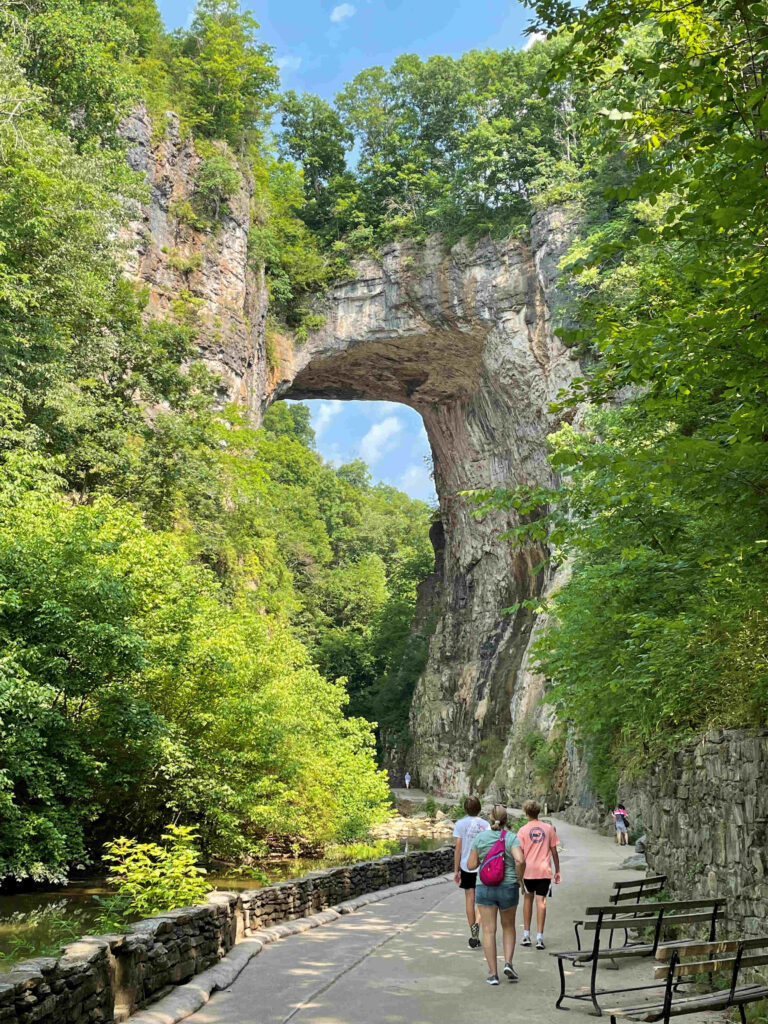Virginia is well known for its history, but it’s quickly gaining recognition as a world-class outdoor destination, too. These historic destinations also happen to have connections to the Great Outdoors, making them ideal spots for an active (and history-filled) vacation.

Photo credit: Rich Grant
James Madison’s Montpelier—Montpelier Station
There are more than eight miles of walking trails within James Madison’s Montpelier estate, winding through horse pastures, wildflower meadows and forests. Plan your route along a few of the different trail loops to catch stunning views of the Blue Ridge Mountains. One of the most popular trails filled with history, the Montpelier Civil War Trail is a one-mile trail that follows the path of McGowan’s Brigade, passing the archaeological remains of a Confederate winter camp. This route also connects to the farm of George Gilmore, a Black man who was born into slavery in 1810 but would live to become a farmer and landowner after Emancipation swept through the South.
Appomattox Court House National Historical Park—Appomattox
As the Civil War drew to a close, Confederate General Lee met with Union General Grant at the McLean House within Appomattox Court House National Historical Park to draw up the terms of surrender. Visit the park today to see historical actors tell the stories of local residents during the day in 1865, and then wander the miles of hiking trails within the park property as you imagine what the landscape would have looked like during the close of the Civil War. From the North Carolina Monument, follow the History Trail, a 4.5-mile trail that encompasses areas where both Union and Confederate armies were fighting during the Battle of Appomattox Court House. The trail runs through open fields, shaded woods and the picturesque Appomattox River, ending at the site of Lee’s headquarters during the surrender.
George Washington’s Mount Vernon—Mount Vernon
Located south of Alexandria, George Washington’s Mount Vernon estate is one of Virginia’s most beloved historic sites. Rather than driving to or from Alexandria, consider taking the Mount Vernon Trail, an 18-mile multi-use paved trail that stretches from the estate to Theodore Roosevelt Island, connecting with regional trails along the way. You can either bike or walk the trail to Mount Vernon, and public restrooms, picnic areas and trash cans spaced along the trail allow for necessary breaks.
Colonial National Historical Park—Yorktown
Colonial National Historical Park contains several iconic historic sites within the 8,600+ acres of coastal preserves, including the Colonial Parkway, Historic Jamestowne, the Jamestown Settlement and Yorktown Battlefield, with Colonial Williamsburg on the border. The park spans parts of the City of Williamsburg and York, James City, Gloucester, and Surry Counties, extending between the York and James Rivers. Hiking and biking are popular outdoor activities within Colonial National Historical Park, as well as kayaking, canoeing, and fishing on the rivers. Bikes are permitted on most of the Colonial Parkway, but you can also tour Yorktown Battlefield on a seven-mile Battlefield Tour, marked by red arrow signs, or a nine-mile Encampment Tour, marked by yellow arrow signs.
Natural Bridge State Park—Natural Bridge
One of Virginia’s most awe-inspiring natural landmarks, Natural Bridge State Park has several historic ties to boast. Thomas Jefferson once owned the 215-foot tall limestone gorge, and today, a Monacan Indian Village interpretation inside the park gives visitors a peek into how the residents prior to Colonial settlers would have lived on the lands. There are various trails crisscrossing the park’s mountainous landscape open to hikers. The mail trail, Cedar Creek, is about a mile long, and its namesake watering hole is stocked with fish, welcoming visitors to cast a line.
 Escape To The Southeast Escape To The Southeast
Escape To The Southeast Escape To The Southeast
